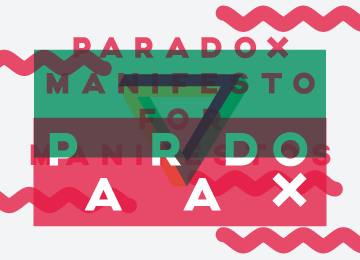This is my manifesto! Say it: man-i-fes-to. Satisfying, is it not?
As a designer, the word manifesto evokes for me this romanticized image of a smoky, scantily lit basement room full of bespectacled design legends scheming up plans. I want to belong to that club, hidden away in the shadows, dictating the direction of design to come.
But what exactly is it that attracts me to this romanti-festo fantasy? I will admit, it is a secret self-righteousness that wants to believe my actions and approaches are better than others. This admission speaks to the dubious paradox of the design manifesto— that design manifestos are both honest declarations of ethos that better the profession, and also, sadly ego-fueled acts of self-justification. Do the benefits of the manifesto outweigh the potential pretentiousness? And are we so unsure of our profession that we must continually prove ourselves through verbose manifestos?
To make matters worse, as insistent as we are about manifestos, we rarely follow them! Art history is full of contradictory manifestos that label their author a hypocrite. Even more, If we believe that design is a response to context, then why do we continually inundate it with rules and aesthetic dogmas? Is not every approach valid?
Hypocrisy abounds!
These contradictions keep the manifesto in a “sacred-zone.” We reserve the responsibility of the manifesto to those shadowy figures. Yet, as mystical and inspiring as those figures may be, the world demands action! So what shall we do? We shall write more manifestos!
Let us embrace the manifesto paradox by accepting there is no paradox.
Our profession is built upon contradiction. We thrive on duality. Designers bridge free-spirited creativity and rigid logic. When paradox is inherent in every action, it is no longer significant— it just is. Let us encode this belief into our manifestos.


Let us write manifestos for ourselves, by ourselves, for everyone to see.
Manifesto like no one is watching, be an example of mindfulness by being obnoxiously self-righteous.
Let us write our manifestos to destroy our manifestos.
Like scribbling down experiences during psychotherapy, we should visualize and share manifestos to move past our manifestos.
Let us write heady manifestos in 500 words or less.
We should not limit our thoughts, only the amount of ink spilled in their cause.
Let us create rigid rules to break the rules.
Define, contextualize, and organize to be free of definition, contextualization, and organization.

Let us establish timeless insights from fleeting reactionary ones.
The manifesto will always aim to solidify views, processes, and beliefs that are, by nature, temporary reactions to circumstance. Only time can we identify those which will endure.
Lastly, let us realize our written manifestos won’t change the world, but writing them will.
Can our manifestos inspire the masses, radically re-thread the fabric of our profession, and the world? Who knows. But the passion that drives us to self-reflect, to critique our processes, and the courage to do so at risk of being labeled a hypocrite, most definitely will.